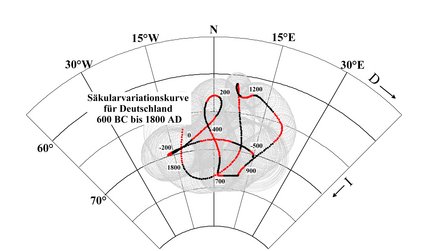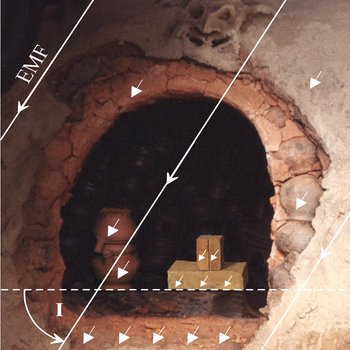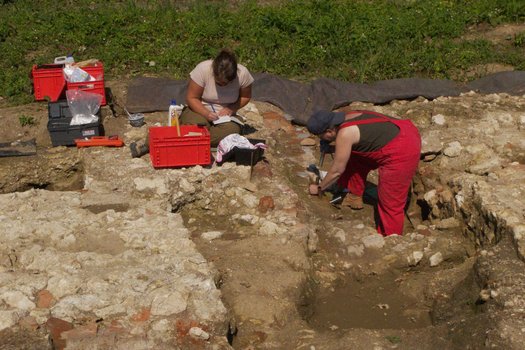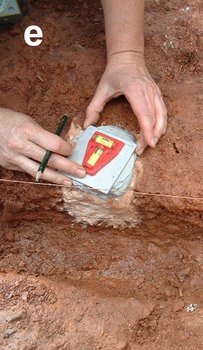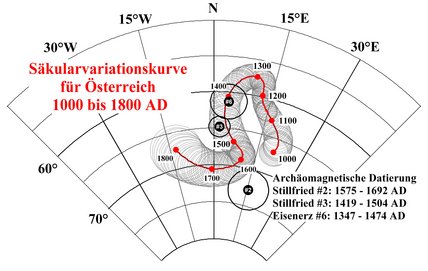Archaeomagnetism
Secular variation of the geomagnetic field during the last millennia
The secular variation of the geomagnetic field is recorded in young rocks and heated archaeological structures. Palaeomagnetic measurements on such material enable us to collect the secular variation for the past with a time resolution in the range of decades. Using this data, the description of the geomagnetic field can be continued for the last millennia using spherical harmonic expansion which was obtained from historical data of the past 400 years.
Time series of the secular variation contribute to a better geophysical understanding of the geomagnetic field; at the same time they can be used for dating young rocks and archaeological findings.

The variation of archaeomagnetic intensity since 1500 BC
FWF Project P223295 (2011-2014)
A sufficiently dense data base of secular variation is essential for models of the geomagnetic field, not only concerning the direction but in particular for the archaeointensity. While Western, Central and Southern Europe are covered quite well with archaeodirections for the past 2000 years, the number of intensities is rather low and they show a wide dispersion. So far, only the data for the past 700 years is dense and precise enough. The main aim of the project is to carry out measurements of archaeointensity at find spots with known archaeodirections. We hereby hope to increase the data set of archaeomagnetic total vectors of Central Europe for the past 3500 years from one or two values per century to approximately five values per century.
We intend to reach this aim by using a new palaeointensity method, which will initially be tested. The desired large data set of archaeomagnetic total vectors will provide the data base for an improved model of the geomagnetic field for the past 3500 years.
During this time interval, five archaeomagnetic jerks occurred which are defined by the rapid changes in the movement of the direction vector. Between 800 and 500 BC, a strong increase in archaeointensity correlates with a more humid and colder climate in Central Europe. This also applies to the increased archaeointensities around 800 AD. An increased 14C-production leading to plateaus in the 14C-calibration curve can be observed in both time intervals. This supports correlations between the geomagnetic field and processes in the atmosphere which regulate the radio nuclide production or cloud formation. The project will provide a significantly improved data base for the respective global geomagnetic field models, leading to a better understanding of the correlation between geomagnetic field, 14C-production and climate.

The archaeomagnetic total vector field in Central Europe
FWF Project P19370-N19 (2006-2010)
The main goal of this project was to test the hypothesis of a possible relation between the behaviour of the geomagnetic field and changes in climate. French collegues argue that during the last 3000 years, the curve of the secular variation (changes in the direction and intensity of the field on time scales from decades to centuries) shows relatively rapid changes in the movement (spikes) of the field direction. Based on individual intensity data from France and Syria, four of the spikes seem to correlate with maximum intensities of the geomagnetic field. This phenomenon is referred to as ‘archaeomagnetic jerk’ and a correlation with advances of the Alpine glaciers has been assumed. Mechanisms for possible correlations between geomagnetic field and climate are discussed very controversially.
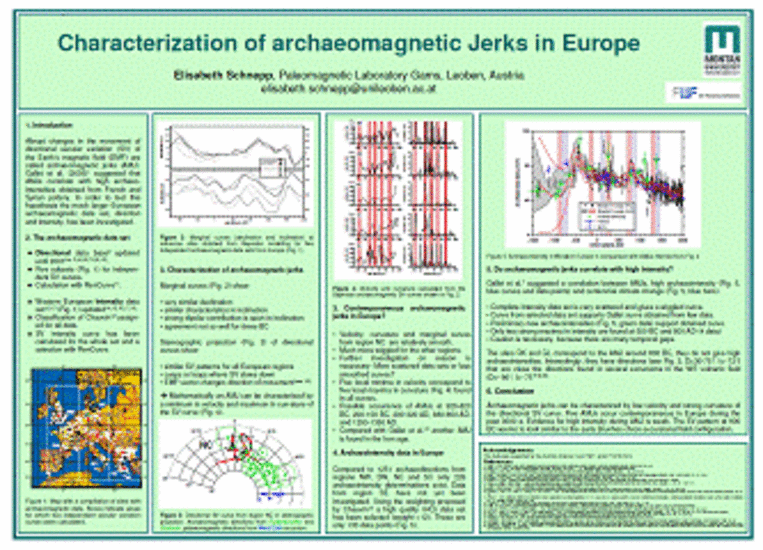
In the framework of this project, we were able to show through the examination of the whole data set of the archaeomagnetic directions that five spikes in the secular variation curves occur simultaneously across Europe in time windows of one century each. We then recorded a set of archaeomagnetic total vectors from archaeological find spots in Austria, Germany and Eastern France. This data set covers the past 3500 years, with at least one intensity and directional value (gained from the same archaeological structure) per century. It also contains structures which recorded the spikes in secular variation. Even though strong changes in archaeointensity occur within the last 3500 years, no correlation can be seen between high intensities and spikes in the direction curve, except for the 8th century AD. On the contrary abnormally low intensities were measured for the spike occurring in the 8th century AD. Actually only two very distinctive intensity maxima occur during the 5th century BC and 8th century AD. The strong increase between 800 and 500 BC correlates with increasing rainfall and a colder climate throughout Europe, and the same applies to the intensity maximum occurring at around 800 AD. In both time intervals a decrease in radiocarbon production rate, which leads to long plateaus in the radiocarbon calibration curve, has also been recorded. Consequently the established correlation between geomagnetic field and radionuclide formation could also play a role in the processes of cloud formation in the upper atmosphere. However, a larger data base is necessary for improved models of the geomagnetic field. An additional result of the project is a secular variation curve which expands the time frame for archaeomagnetic dating in Central Europe to 3500 years and provides a new dating tool for prehistory which helps to solve the problems of the radiocarbon plateaus for the late Bronze and pre-Roman Iron Age.
The main goal of the project was to build up a data base for an archaeomagnetic secular variation curve of Austria covering the past 4000 years and to also collect intensity values for this time interval.
Using the archaeomagnetic calibration curve for Austria created in this project archaeomagnetic datings within the last 2300 years can be performed. This method for the dating of in situ findings like furnaces or ovens is now available to archaeology.

AARCH: Archaeomagnetic Applications for the Rescue of Cultural Heritage (2003 - 2006)
Research network within the framework of the EU mobility programme for young researchers
Partners:
- Department of Archaeological Sciences, University of Bradford (GB)
- Centre De Physique Du Globe De L'IRM, Dourbes (Belgium)
- Geophysical Institute, Sofia, Bulgarian Academy of Sciences (Bulgaria)
- Department of Earth Sciences, Geophysical Laboratory, University of Aarhus (Denmark)
- Laboratoire D'archeomagnetisme, Centre National De La Recherche Scientifique, Rennes (F)
- Department of Geophysics, Aristotle University of Thessaloniki (Greece)
- Facultad De Cc.Fisicas, Universidad Complutense De Madrid (Spain)
- Geomagnetism Laboratory, University of Liverpool (GB)
- Department of Geological Sciences, University of Plymouth (GB)
- Dipartimento di Scienze della Terra, Universitá degli Studi di Torino (I)
- Dipartimento di Scienze della Terra, Universitá degli Studi di Napoli (I)
Link to Project-Website (Institut Royal Météorologique, Dourbes, Be)
Publications
Schnepp, E., Lanos, P., Hervé, G., Scholger, R., Mauritsch, H., Rolf, C. (in prep.) New archaeomagnetic data from Austria and Germany
Brüggler, M., Rehren, T., Schnepp, E., Hartkopf-Fröder, C. (in prep.) A Late-Roman Glass Workshop near Goch-Asperden, Rhineland/Germany – Features and Analyses.
Rolf, C., Hambach, U., Novothny, A., Horváth, E. & Schnepp, E. (2013): Dating of a Last Glacial loess sequence by relative geomagnetic palaeointensity: A case study from the Middle Danube Basin (Sütto, Hungary).
Quaternary International (in press)
Schnepp, E., (2011): Archäo-, Paläo- und Umweltmagnetik. In: Hans-Rudolf Bork/Harald Meller/Renate Gerlach, Umweltarchäologie - Naturkatastrophen und Umweltwandel im archäologischen Befund. 3. Mitteldeutscher Archäologentag vom 07. bis 09. Oktober 2010 in Halle (Saale). Tagungen des Landesmuseum für Vorgeschichte Halle, 6, Landesamt für Denkmalpflege und Archäologie Sachsen-Anhalt , Halle (Saale), 57-69.
Hervé, G., Schnepp, E., Chauvin, A., Lanos, P., Nowaczyk, N. (2011): Archeomagnetic results on three First Iron Age salt-kilns from Moyenvic (France).
Geophysical Journal International, 185, 144–156
Schnepp, E., Lanos, P., Chauvin, A. (2009): Geomagnetic paleointensity between 1300 and 1750 A.D. derived from a bread oven floor sequence in Lübeck, Germany.
Geochemistry Geophysics Geosystems, 10, p. Q08003 (open access)
Aidona, E., Scholger, R., Mauritsch, H.J., Perraki, M. (2008): Remanence aquisition in a Roman-style gold furnace.
Phys. Chem. Earth, 33, 438-448
Hambach, U., Rolf, C., Schnepp, E. (2008): Magnetic Dating of Quaternary Sediments, volcanites and archaeological Materials: an overview.
Eiszeitalter und Gegenwart (Quaternary Science Journal), 57, 25-51
Singer, B.S., Hoffman, K.A., Schnepp, E., Guillou H. (2008): Multiple Brunhes Chron Excursions Recorded in the West Eifel (Germany) Volcanics: Support for Long-Held Mantle Control Over the Non-Axial Dipole Field.
Phys. Earth Planet. Int., 169, 28-40.
Trapanese A., Batt C. M., Schnepp E. (2008): Sampling and orientation methods in archaeomagnetic dating: a comparison using case studies from Wörterberg, Eisenerz and Gams Valley (Austria).
Phys. Chem. Earth, 33, 414-426
Schnepp, E., Worm, K. and Scholger, R. (2008): Improved sampling techniques for baked clay and soft sediments.
Phys. Chem. Earth, 33, 407-413
Schnepp, E. (2007): Archäomagnetische Datierung in Deutschland und Österreich.
Archäologisches Korrespondenzblatt, 37, 2, 313-320
Schnepp, E., Lanos, P. (2006) A preliminary secular variation reference curve for archaeomagnetic dating in Austria.
Geophys. J. Int., 166, 91–96
Aidona, E., Scholger, R., Mauritsch, H. J., Schnepp E., Klemm, S. (2006): Spatial distribution of archaeomagnetic vectors within archaeological samples from Eisenerz (Austria).
Geophys. J. Int. 166, 46–58
Schnepp, E., Lanos, P. (2005): Archaeomagnetic secular variation in Germany during the past 2500 years.
Geophys. J. Int, 163, 479–490
Lanos, P., Le Goff, M., Kovacheva, M., Schnepp, E. (2005): Hierarchical modelling of archaeomagnetic data and curve estimation by moving average technique.
Geophys. J. Int., 160, 440-476
Korte, M., Genevey, A., Constable, C., Frank, U., Schnepp E. (2005): Continuous geomagnetic field models for the past 7 millennia I: A new global data compilation.
Geochem. Geophys. Geosyst., 6(2): 1-32, Q02H15
Schnepp, E., Pucher, R., Reinders, J., Hambach, U., Soffel, H.C. und Hedley, I. (2004): A German catalogue of archaeomagnetic data.
Geophys. J. Int., 157, 64-78
Schnepp, E., Pucher R., Goedicke, C., Manzano, A., Müller, U., Lanos, P. (2003): Paleomagnetic directions and TL dating from a bread oven-floor sequence in Lübeck (Germany): A record of 450 years of geomagnetic secular variation.
J. Geophys. Res., 108, B2, 2078
